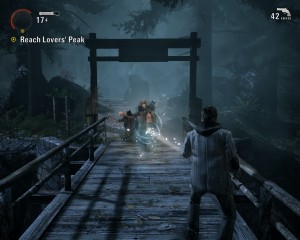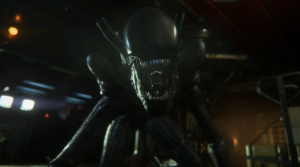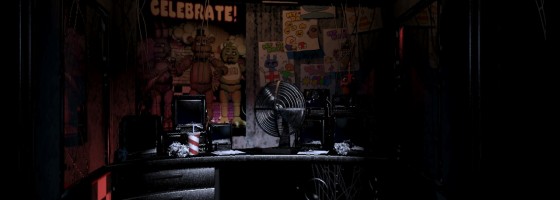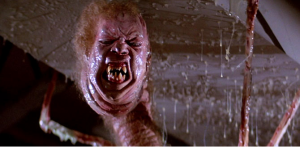Today’s post is not completely about the game industry, so please indulge me on this one. The horror genre has gone through a number of changes over the decades to where it is now: From the days of Dracula and Frankenstein, to modern horror with the likes of Five Nights at Freddy’s and Paranormal Activity.
When I think about how much horror has changed as a genre, I can think of the shift from the 80’s to where we’re at now as the big differing point that I wanted to talk about.
Putting a Face on Horror:
When you look at a lot of horror movies pre 00, the majority of them feature a title antagonist: Pinhead, Kruger, Mike Myers, Jason and so on. Even John Carpenter’s the Thing had an antagonist in the form of the Thing, even though we didn’t truly “see it;” see also Alien.
These antagonists commanded your attention and made their presence known multiple times throughout the movie. Sometimes the audience got to see things from the killer’s perspective or use their omniscient viewpoint to see something before the victim.
In these movies, the feel of the horror was the hunter going after the hunted. While the antagonist had multiple appearances, they didn’t get the most screen time until the final minutes of the movie, where the remaining survivors usually go head-to-head with them.
While this worked to create some of the most memorable horror franchises, it also limited them.
When your movie is based on one antagonist, that locks each movie into the same formula and same situations; how many times can people open that damn puzzle box anyway?
With the 00’s and the advances in CGI, horror filmmakers have moved to a more larger-sense of horror.
The Force of Horror:
Horror movies today tend to focus less on one primary antagonist, and more of a force of nature. In these movies, you rarely (if at all) see a primary antagonist, and instead, you see their carnage or impact on the people of the movie. These movies may have a main antagonist, but they only appear until the very last scene of the movie.
Instead of it being seen as a hunter/hunted concept, these horror movies are about a force of nature, or something that can’t be stopped, messing with people. In these movies, it’s rare for the people to get out alive and they usually end with everyone being killed.
More often than not, the goals or motivation of the antagonist are never explained in the same way as they were with Pinhead or Kruger. Besides being more mysterious, this also has the effect of the filmmaker getting more mileage out of these characters and situations.
With a story like Nightmare on Elm Street, you have an idea of who Freddy is and what he wants, but when you have something like the spirit of The Conjuring or Paranormal Activity, you can keep coming up with new stories or situations as their motivations are never fully known. This is also why a lot of classic horror series had their infamous drops in quality over the four, five + movie franchises.

Alan Wake, like a lot of horror games, focuses on a force or faceless entity that is controlling the situation
Zombie movies can also be considered a force of nature-type horror experience. Outside of campy movies, the zombies are never shown to have a personality and act as a swarm devouring anything in its path. While there can be survivors at the end of these movies, the situation is normally never really fixed.
Because of the ability to continue a series, this is why the video game industry has certainly embraced the “force of nature” aspect of horror.
Sustaining Terror:
The horror genre when it comes to video games with rare exception tends to prefer force of nature horror experiences. The added tension of not understanding the motivations or rules of the situation do a lot to increase the tension and fear. Games like Five Nights at Freddy’s, Layers of Fear and even Silent Hill, all deal with a mysterious force of circumstance going on.
By the end of the game, we don’t have any deeper insight into the exact situation or threat of the antagonist; making it easier to keep the series going. There is never an evil mastermind pulling the strings or interacting with the player.
I know what you’re thinking, “What about Freddy?” Freddy’s motivations are never explained beyond just if he reaches you, you’re dead. With each game in the series, the setting is completely different, because the threat of Freddy and the other animatronics can be translated that way.
There are only a handful of video games that come to mind that deal with an antagonist going after the player: Eternal Darkness, Clock Tower and Alien Isolation immediately come to mind. While the Dead Space series usually has some evil person who is responsible for the necromorphs, they are usually dealt with quickly for the player to focus on some representation of the necromorph consciousness.

Having the antagonist take center stage allows you to use them more frequently compared to modern horror
Perhaps the most famous example of this would be the Resident Evil series. While the series has had a villain in the form of the Umbrella Corporation, the player is usually too busy dealing with the affects of whatever virus or parasite going on to really care.
Any interactions between the antagonist and the player usually happen in cut-scenes or the final battle, but never over the course of the game.
Hunted:
I would love to see more horror games go with the hunter/hunted approach. Even though they are harder to continue, the shorter plays would work better with the pacing that goes with a horror game. Alien Isolation has showed just how much more tense it is when you have something actively going after the player as opposed to a passive experience.
Another bonus is that it would bring back that tension of fight or flight that I’ve talked about multiple times in the past. While Resident Evil 7 is still a long way from being released, I hope that this is another major transformation point for the series, and one that other horror designers can learn from and continue to grow with.
If you enjoyed this post, you can follow me on twitter @GWBycer or on YouTube for daily content. Please check out the Patreon campaign to secure monthly funding. Your donations will allow me to keep working and growing Game-Wisdom with new content.


